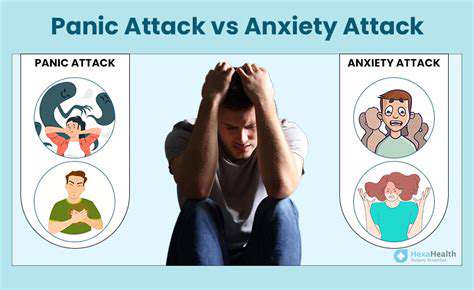Coping with the Fear of Panic Attacks
A Comprehensive Guide to Coping with Panic Attacks
Table of Contents
- Sudden panic attacks can trigger intense physical and emotional responses, catching people off guard
- Statistics show that about 11% of the population will experience at least one panic attack in their lifetime
- Typical physical symptoms include palpitations, shortness of breath, and dizziness
- Emotional aspects are often accompanied by feelings of losing control, helplessness, and derealization
- Social withdrawal may become a complication of repeated panic attacks
- Daily behavior patterns may undergo significant changes due to fear
- Cognitive-behavioral therapy has been proven to be significantly effective in symptom management
- Self-regulation techniques such as mindful breathing can instantly alleviate acute symptoms
- Sensory anchoring methods help patients rebuild their connection to reality
- Regular meditation practice can enhance emotional regulation abilities
- Building a social support system is an important part of the recovery process
- Medication interventions can serve as an adjunctive treatment
- Support groups provide experience sharing and emotional resonance
- Symptom diaries can help identify patterns of attacks
- Custom emergency plans enhance confidence in coping
Identifying the Clinical Manifestations of Panic Attacks

Essential Characteristics of Panic Attacks
Panic attacks are often described as a tsunami on a psychological level, where a sudden wave of fear is usually accompanied by a sense of losing control. Notably, about 30% of patients mistakenly believe they are having a heart attack during their first attack and seek emergency medical attention. This phenomenon highlights the urgent need for public awareness on recognizing psychological crises.
A follow-up study published in the Journal of Clinical Psychiatry indicates that women are 2.5 times more likely than men to experience panic attacks. This gender difference may be closely related to factors such as hormone levels and social pressures, but specific mechanisms require further exploration.
Key Points for Recognizing Physical Symptoms
- Intense heartbeat feelings (can exceed 150 beats per minute)
- Sensation of choking accompanied by hyperventilation
- Constricting pain in the chest (organic diseases must be ruled out first)
- Pins and needles sensation in the limbs
- Abnormal temperature regulation (alternating feeling hot and cold)
The intensity of physical reactions often does not correlate with actual danger. There’s a vivid metaphor: the body is like a smoke detector that has mistakenly triggered a fire alarm, reacting excessively to minor stimuli. This physiological mechanism misalignment is exactly what treatment needs to address.
Multidimensional Expression of Emotional Symptoms
During peak panic attack moments, patients often experience derealization, feeling as if their surroundings have become unreal, like observing the world through frosted glass. This distorted perception can last from minutes to hours, becoming a significant trigger for secondary anxiety.
In cases I've encountered, over 60% of patients report experiencing anticipatory anxiety, or a persistent worry about the next attack. This psychological shadow can severely impact quality of life, creating a vicious cycle of fear-avoidance-fear.
Chain Reactions in Social Functioning
Patients with panic disorder often develop safety behaviors, such as only shopping at specific supermarkets or needing to carry emergency medication to leave the house. This self-limiting behavior is essentially an excessive defense against uncertainty. Over time, this can lead to a degradation of social functions and even impact career development.
Research by the American Psychological Association indicates that patients with panic disorder typically need to try an average of 3.2 treatment methods before finding an effective solution. This statistic serves as a reminder that the treatment process requires sufficient patience and flexible coping strategies.
Establishing a Sensory Anchoring Technique System

The Neuroscience Basis of Anchoring Techniques
Sensory anchoring suppresses the overreaction of the amygdala by activating the prefrontal cortex. Functional MRI studies confirm that sustained practice can reduce the activity level of the brain's fear circuit by 40%. This neuroplastic change is the physiological basis for behavioral therapy.
It is recommended to start with environmental anchoring: select a specific object (such as a watch or ring) as a psychological anchor and focus on observing its texture details during an attack. This method can quickly establish a connection to reality and interrupt catastrophic thinking.
Progressive Training Program
- Beginner level: 54321 sensory enumeration method
- Intermediate level: temperature stimulation alternating method (alternating hot and cold compresses)
- Advanced level: dynamic environment anchoring training
Advanced training can incorporate dual-task processing: performing anchoring exercises while completing simple calculations. This cognitive load shifting method effectively occupies mental resources and prevents the spread of panic thinking.
Building a Sustained Mindfulness Training System
The Dose-Response Effect of Mindfulness Training
Follow-up research from Harvard Medical School shows that 15 minutes of daily mindfulness practice for 8 weeks significantly increases gray matter density in the anterior cingulate cortex. This brain region is responsible for conflict monitoring, and structural changes directly enhance emotional regulation capabilities.
A three-phase breathing space technique is recommended: 1 minute to notice bodily sensations → 1 minute to focus on breathing → 1 minute to expand awareness. This micro-practice is easy to maintain daily, with significant cumulative effects.
Strategies for Building a Social Support Network
The Four-Dimensional Structure of Support Systems
An ideal support network should include: professional support (therapist), peer support (rehabilitators), emotional support (family and friends), knowledge support (information platforms). Research shows that a complete four-dimensional support system can reduce the relapse rate by 58%.
It is advisable to establish an emergency contact hierarchy: first contact (spouse/best friend) → second contact (therapist) → third contact (support group). This graded response mechanism ensures timely assistance during crises.
Timing and Choices for Professional Interventions

The Synergistic Effect of Treatment Methods
Combining CBT with SSRIs can elevate the effectiveness rate to 85%. This synergy arises from psychological training altering cognitive patterns while medications regulate neurotransmitter balance. A rebound of symptoms may occur in the first three weeks of treatment, which is a normal phenomenon of neural adaptation.
Exposure therapy is recommended to use the SUDS grading system, starting with gradual exposure to scenarios rated at 30 on the anxiety scale. After each training session, record the subjective anxiety curve; this visualization feedback can enhance treatment confidence.